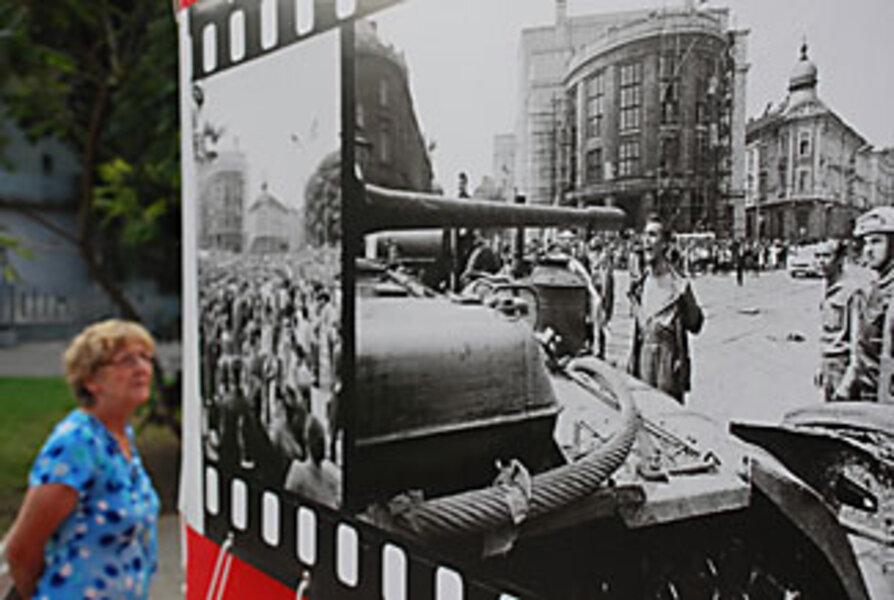Amid Russia-Georgia standoff, iconic photo of 1968 Soviet invasion
Loading...
| Bratislava, Slovakia
Before the 1989 photo of a Chinese man confronting tanks in Tiananmen Square, there was the 1968 Soviet invasion of Czechoslovakia captured by Ladislav Bielik's iconic image of a protester in Bratislava baring his chest to the barrel of a Soviet tank – 40 years ago Thursday.
The moment is brought to life here in Slovakia's capital, where Bielik's sequential batch of 185 photos are featured in a photo exhibit on the same square where ordinary citizens confronted the Soviets that morning.
Bielik, whose office was just around the corner, shot them the morning of Aug. 21, only hours after tanks rolled in to snuff out a glimmer of democratic reform known as the Prague Spring.
"You can read a history book about what happened then, or someone will say 'There were tanks here,' but when you see these photos, you know it was real," says student Tanya Takacova, born just before the 1989 collapse of communist Czechoslovakia.
While Bielik's photos drive the Slovak narrative of that Soviet-led invasion, some cannot resist drawing broader parallels between Moscow's aggression then and its recent invasion of Georgia.
"This is no longer 1968 and the invasion of Czechoslovakia, when a great power invaded a small neighbor and overthrew its government," said US Secretary of State Condoleezza Rice last week in criticism of Moscow.
Radio Prague quoted one Czech man as saying, "Russia never changes.... They're incapable of being free, so they don't want anyone else to enjoy their freedom."
But while most of Eastern Europe – and Slovakia's fellow NATO members – are urging a hard-line response to Russia, Slovak officials take a different view.
"Somebody provoked, and we know who," Prime Minister Robert Fico said recently. "Then came a reaction which was very forceful." Other top political figures accused Georgia of attempted "genocide" and "war crimes."
An explanation lies partly in differing views of the Prague Spring. "If you compare Slovak and Czech reactions, there is one key difference: the Soviets attacked the Czechoslovak leadership in Prague, which many Slovaks themselves did not identify with," says Ivo Samson, a senior researcher at the Slovak Foreign Policy Association. "Compared with Czech attitudes in the streets and in political parties, anti-Russian feelings are much more charged than in Slovakia."
Still, Bielik's photos have come to symbolize for Slovaks the powerlessness of their small country against an armed aggressor. Though international news agencies picked up the photo of the bare-chested man, stirring international outrage at Soviet brutality, only local authorities knew the photographer's identity. As the Soviets quickly reimposed their will, Bielik was kicked off his newspaper's staff the next month.
Though both Bielik and his subject have since died, the photo was included by American Life magazine's "100 Photographs that Changed the World."
"These photos are authentic documentation of the greatest moment from 40 years ago," says Slovak Ivan Mudroch, who in 1968 had just been to the cinema with friends when he saw the tanks on the street. "For the older generation, this is our history. For the younger generation, well, it's a more complicated question – they should be more interested."





